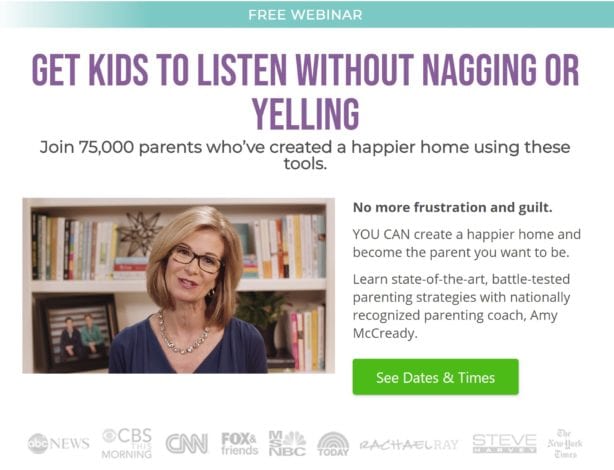If I have to tell you one more time…
I’m not going to tell you again…
Did you hear what I said?
How many times have you found yourself saying these things to your child?
You ask them to do something, give them a gentle reminder and repeat the instructions again. And they still don’t appear to have listened to a single word you’ve said.
When your child doesn’t listen, then you can become the shouty, naggy parent you never wanted to be. If this sounds familiar then you’re not alone. Here’s how get kids to listen without yelling.
Don’t talk until you’ve got their attention
If your child is busy playing with something, then they’re probably fully-focused on that toy or game. It can mean that they will block out any other sounds or sights.
So when you talk to them from the other side of the room, the chances are they won’t pay attention. Either they won’t tune into you or they’ll choose NOT to hear you.
As a first step, go close to them. Get down to their eye level and connect with them. Do this before you ask them to do what you need them to do.
Talk about the game they’re playing or the picture they’re drawing. And when you have their attention, tell them what you want them to do.
Use your child’s name
Using their name gets their attention and helps them to stop and listen. Preface any instructions with their name, like:
Hannah, will you please…

Use Positive Parenting Resources
There are many Positive Parenting courses that you could try.
The one we recommend is Positive Parenting Solutions by Amy McCready: Positive Parenting Solutions Review.
If you want to see what’s inside the course she offers a free 1 hour long positive parenting webinar which gives you some actionable tips: Free Positive Parenting Solutions Free Parenting Class
Make it a statement rather than a question
A common mistake parents make is to word instructions as questions, such as:
Would you like to put your shoes on now so we can get ready to go?
We mean it as a nice and gentle way to coax them into action. But the trouble with this approach is that a child who is busy playing will probably say ‘No’.
Fair enough. It’s an honest answer.
But they can then stick to this no. And this can then build up into a battle of wills.
It also doesn’t get you out of the house in time for school drop off. Simple commands are more effective, like
Time to get your shoes on.
Offer them a simple choice
There’s one exception to the ‘no questions’ rule. That’s when you give your child a choice.
The trick is to offer them only two choices, both of which get the job done. So you might ask:
Time to get dressed. Do you want to wear your blue jumper or the green one?
Or you could try:
Do you want to eat your pasta with a fork or a spoon?
Or even:
Do you want to hop to the car like a bunny rabbit or zoom like a racing car?

Keep instructions simple and clear
Toddlers and little kids respond better to short and clear instructions. So:
It’s time to get our shoes and get in the car.
works better than:
We really need to go now or we’ll be late. And I’m worried about the traffic so we’d better get ready to go.
Keep it simple. Keep it clear.

Turn negatives into positives
How many times in a day do you say ‘No’ or ‘Don’t’ to your child? Some days it can feel like it’s all too many.
A simple trick to counter this is to turn negatives into positives. Instead of telling your child what they can’t do, tell them what they can do. So instead of saying
Don’t shout
Try:
Remember to use a quiet voice when we’re inside.
Instead of:
Don’t throw your food on the floor
Turn it into:
Let’s keep food on our plates.
The ‘When…..then’ technique
Little kids like to feel in control and they love to know what’s coming next. That’s why this technique works so well.
You could say:
When you get out of the bath and get dressed, then we can snuggle up and read a bedtime story.
It offers your child a reward after they’ve carried out the boring task you want them to do.
Speak calmly and quietly
If your child is not listening, instead of raising your voice, try lowering it. This is especially useful if your child is getting cross and beginning to have a meltdown.
Get up close to them and talk in a soft, quiet voice. It can get their attention and make you seem more serious.
Being quiet and staying calm can help them regulate their own emotions too.
Say ‘I want’
This is helpful for kids who want to please but don’t like orders.
Instead of saying:
Get down
Try:
I want you to get down.
A simple change in how you phrase it can make all the difference.
The one-word statement
When it comes to Tweens and Teens a one-word statement can hold a great deal of power. It can save time, breath and a lot of nagging.
Saying one word such as: ‘Dog’, ‘Clothes’ or ‘Bins’ gives your older child the chance to use his initiative.
So when he hears ‘Dog’ he might think
Oh yes, the dog. I told mum I’d take him on a walk.

Be silly
Being playful can work wonders. For example you want your child to brush their teeth. You could grab their toothbrush and make it say in a squeaky voice:
I’m bored. Nobody has used me all day. I want to be busy and brush someone’s teeth.
Instantly you change the mood. You’re working together through play, rather than nagging. And a little fun can get the job done.
What do I do if my child is having a tantrum?
Once your child is in meltdown mode, they won’t hear you. The blood rushes to the primitive part of the brain, which prepares them for either fight or flight.
The parts of the brain that they use for thought and reasoning are not engaged.
This means that if your child is having a tantrum, they often can’t listen to you, no matter what you say. So there’s no point trying to reason with them at this point.
Instead find small ways to calm them down. Some children need hugs and reassurance. Others prefer to have a moment somewhere quiet so they can calm down.
Wait until they’ve relaxed and talk to them then.
What do I do if my child STILL won’t listen?
If you find yourself shouting and yelling every day you’re not alone. It could be worth looking into parenting resources that could help you.
There are a lot of books or parent coaching courses that you could take online. Know that you’re not alone if you’re having problems communicating with your kids.
Positive Parenting Solutions: Online Parent Coaching Course
The course that we have tried and tested is Positive Parenting Solutions by Amy McCready mentioned above, which we highly recommend: Positive Parenting Solutions Review.
It’s a course that’s easy to take. It’s all online and the units are divided into 10 minute chunks so that parents can follow at their own pace. All the tactics are based on Positive Parenting strategies, so no harsh disciplining is involved.
Amy McCready also offers a free 1 hour webinar: Free Positive Parenting Solutions Free Parenting Class
When you talk to kids it’s often not what you’re asking them to do but how you say it that makes a difference.
A few simple tweaks can lead to a big change in their behavior.



